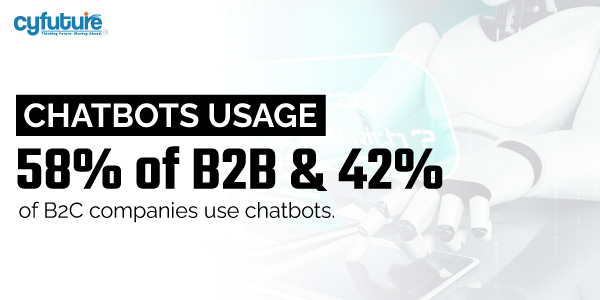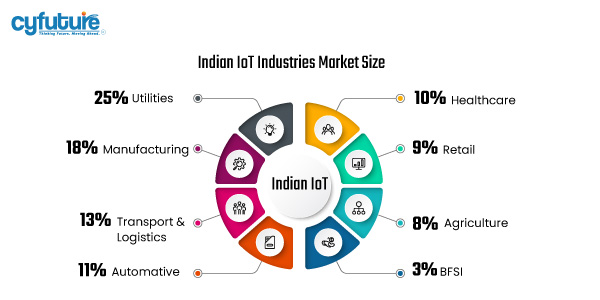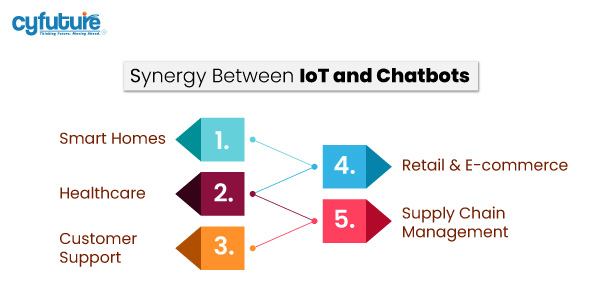Toggle navigation

The digital landscape’s rapid transformation is unparalleled, driven by two powerful catalysts of change: the Internet of Things (IoT) and Chatbots. With its capacity to connect devices and gather data, IoT has ushered in an era of enhanced efficiency and intelligence. According to a Gartner report, ‘Spending on the Internet of Things (IoT) across critical industries surpassed $268 billion in 2022, with an expected annual IoT device growth rate of 15% from 2021 to 2025.’ On the other hand, Chatbots represent the digital conversationalists revolutionizing the way businesses engage with their clientele. Did you know that Granter suggests that by 2027, approximately 25% of organizations are expected to adopt chatbots as their primary customer service channel? What relevance do these statistics hold for individuals in India? Read on to find out more.

IoT represents a web of interconnected physical entities. These include devices, vehicles, structures, and even common objects embedded with sensors, software, and connectivity. These ingenious devices are designed to gather and share data, allowing them to function independently and engage with their surroundings. In simpler terms, IoT empowers inanimate entities to communicate and cooperate, endowing them with ‘smart’ capabilities tailored to perform specific tasks efficiently.
To delve deeper into IoT, it’s essential to grasp a few key concepts:
1. Sensors and Connectivity
Sensors are the fundamental building blocks of Internet of Things (IoT) devices tasked with gathering data from the physical surroundings. Subsequently, this data gets relayed to a central system through various connectivity choices, encompassing Wi-Fi, Bluetooth, or cellular networks.
2. Data Processing
The collected data is processed and analyzed in near-real-time. Advanced algorithms extract valuable insights, enabling informed decision-making.
3. Automation
IoT devices can execute tasks without human intervention based on the data they receive. For example, a smart thermostat can adjust the temperature based on occupancy and weather conditions.
4. Scalability
IoT networks are highly scalable. You can add or remove devices as needed, making them adaptable to changing requirements.
IoT isn’t merely a technological concept; it represents a revolution fundamentally reshaping our way of life and work in India. To fully grasp its impact, it’s crucial to appreciate how it’s catalyzing innovation across a wide range of industries within our nation.”
IoT-powered sensors monitor soil conditions, weather, and crop health. Farmers receive actionable insights, leading to increased yields and resource optimization.
Remote patient monitoring, wearable health devices, and telemedicine are becoming accessible through IoT, enhancing healthcare delivery, especially in rural areas.
IoT-driven automation and predictive maintenance reduce downtime and enhance productivity in Indian factories.
Cities like Jaipur and Pune leverage IoT for waste management, traffic control, and energy-efficient street lighting, improving urban living.
Fleet management systems utilizing IoT enhance route optimization, reduce fuel consumption, and ensure safer transportation of goods.
IoT-driven inventory management systems enhance supply chain efficiency, reducing stockouts and overstock situations.
In recent times, India has witnessed an unprecedented digital revolution unlike any other in its history. Chatbots and digital assistants are central to this sweeping transformation. They have been playing a pivotal role in reshaping the customer service landscape.
At their essence, chatbots represent computer programs meticulously crafted to mimic human conversation. These intelligent entities harness the power of artificial intelligence (AI). Moreover, they employ sophisticated natural language processing (NLP) algorithms to decipher and address user queries.
Traditionally, customer service involved long wait times, frustrating automated menus, and sometimes, limited human assistance. Chatbots have changed this paradigm. They offer instantaneous support, 24/7 availability, and the ability to handle a wide range of customer inquiries.

The adoption of chatbots in Indian businesses has been swift and transformative. Companies across various sectors, from e-commerce giants to financial institutions, have integrated chatbots into their customer service strategies.
Chatbots provide immediate assistance, reducing response times and ensuring customer inquiries are promptly addressed. This level of responsiveness is crucial in today’s fast-paced digital age.
Indian businesses have recognized the cost-saving potential of chatbots. By automating routine customer interactions, they can allocate their human customer service agents to more complex tasks, thus optimizing their workforce.
Chatbots use data analytics to understand customer preferences and behavior. It enables them to offer personalized product recommendations and tailor responses, enhancing the overall customer experience.
Unlike human agents, chatbots are available 24/7 without breaks or holidays. This round-the-clock availability ensures businesses can cater to a global audience without constraints.
Chatbots can offer support in multiple languages in a linguistically diverse country like India, broadening their reach and accessibility.
The convergence of IoT (Internet of Things) and Chatbots has emerged as a potent force. It promises a plethora of advantages for businesses across diverse sectors. Let’s delve into these transformative benefits, supported by compelling real-world case studies that underscore their practical significance.
One of the standout benefits of IoT lies in its capacity to streamline operations effectively. Through the interconnection of devices and the continuous gathering of real-time data, Indian businesses can fine-tune their processes. Thus, minimizing downtime and significantly enhancing overall operational efficiency. A prime example is agriculture, where IoT-powered sensors monitor soil conditions and irrigation needs. This precise data-driven approach has led to increased crop yields, benefiting farmers and the agricultural economy as a whole.
Chatbots, the digital stalwarts of customer interaction, are revolutionizing how Indian businesses engage with their clientele. The banking industry, for instance, has embraced chatbots to provide 24/7 support. For instance, HDFC Bank’s Eva is a chatbot capable of handling customer queries and transactional requests. This proactive approach has not only improved customer satisfaction but has also reduced response times significantly.
IoT has the power to trim operational costs by optimizing resource utilization. IoT-driven fleet management systems have reduced fuel consumption and maintenance expenses in the logistics sector. A notable case study is provided by Mahindra Logistics, which employed IoT solutions to enhance route planning and monitor vehicle health. This strategic move led to substantial cost savings and a greener footprint.
IoT generates a wealth of data, and businesses in India are leveraging this information to make informed decisions. For example, the Fortis Hospital Group has harnessed IoT in the healthcare sector to monitor patient vitals in real-time. It not only ensures timely intervention but also facilitates predictive healthcare analytics, enabling better patient care.
Chatbots, being digital entities, offer the advantage of scalability and accessibility. A noteworthy illustration is that of Swiggy, India’s leading food delivery platform. Swiggy’s chatbot simplifies food ordering, allowing users to place orders effortlessly. This scalable solution has contributed significantly to the company’s growth and customer convenience.
Embracing IoT and Chatbots isn’t just a choice; it’s a competitive imperative. Case in point: Reliance Jio’s widespread IoT deployment for smart cities. By offering IoT services for urban infrastructure, Jio has positioned itself as an innovator in India’s telecom industry, gaining a distinct edge over competitors.
In the continually evolving realm of technology, the convergence of two powerful forces, the Internet of Things (IoT) and Chatbots, has given rise to a digital environment characterized by heightened intelligence, greater responsiveness, and enhanced efficiency. Although these innovations may initially appear distinct, they have unveiled an extraordinary synergy that holds the promise of reshaping entire industries and redefining how customers experience digital interactions.
At the heart of this synergy is the idea of data-driven decision-making. With its vast network of interconnected devices, IoT continuously generates a colossal volume of data. This data, when harnessed effectively, becomes a goldmine of insights. Here’s where chatbots step in – as intelligent conversational interfaces, they excel at processing and extracting meaningful information from this data in real time. This fusion of IoT’s data generation and chatbots’ data processing capabilities creates a powerful loop of information exchange.

Let’s delve into some real-world scenarios where this synergy between IoT and chatbots is driving innovation and efficiency:
In a modern smart home, IoT devices such as thermostats, cameras, and sensors collect data on temperature, security, and energy consumption. Chatbots integrated into these systems can provide homeowners real-time updates and control options through natural language conversations. For instance, you can ask your chatbot to adjust the thermostat or check who’s at the front door.
IoT-enabled medical devices like wearable fitness trackers continuously monitor vital signs. Chatbots in healthcare apps can interpret this data and provide users with health recommendations or alerts based on their health profiles.
In logistics and supply chain management, IoT sensors track the location and condition of goods in transit. Chatbots can relay this information to stakeholders, offering insights into shipment status, delays, and potential issues.
Chatbots in customer support can tap into IoT data to offer proactive assistance. For instance, if an IoT-connected appliance detects a malfunction, the chatbot can guide users through troubleshooting steps or schedule a repair service.
IoT-enabled beacons in retail stores can collect data on customer movements and preferences. Chatbots can use this information to offer personalized product recommendations and shopping assistance.
As IoT expands its reach across various industries and chatbot technologies become more sophisticated, the synergy between them is poised to become even more potent. Businesses are discovering that this combination enhances operational efficiency and elevates customer engagement to new heights.
The collaboration between IoT and chatbots signifies a significant advancement in our pursuit of a more intelligent digital ecosystem. It is evidence of technology’s innovative essence, wherein diverse components converge to form a whole greater than their contributions. As we progress, we can look forward to increasingly inventive applications of this collaboration. Such applications will redefine industries and transform how we engage with the digital realm.
The fusion of IoT and Chatbots represents a pivotal advancement in India’s digital landscape. The Internet of Things (IoT), known for its ability to gather data, and Chatbots, valued for their conversational intelligence, are jointly reshaping the landscape of business operations and customer interactions. This collaborative potential offers a significant opportunity to elevate efficiency, reduce expenses, and foster innovation across many industries.
Embracing IoT and Chatbots is no longer a choice but a necessity in today’s rapidly evolving digital world. Their collective power to streamline processes, improve customer experiences, and offer data-driven insights is invaluable. As India strives for greater efficiency and competitiveness, integrating these technologies becomes imperative for businesses seeking to stay ahead.
At Cyfuture, we’re dedicated to helping you harness the full potential of IoT and Chatbots. Stay tuned for further insights and innovations in this ever-evolving technological landscape.
How can chatbots enhance IoT applications?
Chatbots can improve IoT applications by providing a user-friendly interface for controlling and receiving information from IoT devices, making them more accessible and efficient.
What types of tasks can IoT chatbots handle?
IoT chatbots can perform tasks such as device control, data retrieval, status updates, and providing insights based on IoT data.
Are IoT chatbots limited to specific industries?
No, IoT chatbots have applications across various industries, including healthcare, manufacturing, retail, and smart homes.
What’s the future outlook for IoT chatbots?
The future of IoT chatbots is promising, with advancements in AI and IoT technologies leading to more sophisticated, user-friendly, and versatile applications.